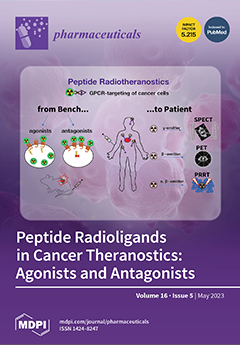Drugs that cure COVID-19 have been marketed; however, this disease continues to ravage the world without becoming extinct, and thus, drug discoveries are still relevant. Since M
pro has known advantages as a drug target, such as the conserved nature of the active site and the absence of homologous proteins in the body, it receives the attention of many researchers. Meanwhile, the role of traditional Chinese medicine (TCM) in the control of epidemics in China has also led to a focus on natural products, with the hope of finding some promising lead molecules through screening. In this study, we selected a commercial library of 2526 natural products from plants, animals and microorganisms with known biological activity for drug discovery, which had previously been reported for compound screening of the SARS CoV-2 S protein, but had not been tested on M
pro. This library contains compounds from a variety of Chinese herbs, including
Lonicerae Japonicae Flos,
Forsythiae Fructus and
Scutellariae Radix, which are derived from traditional Chinese medicine prescriptions that have been shown to be effective against COVID-19. We used the conventional FRET method for the initial screening. After two rounds of selection, the remaining 86 compounds were divided into flavonoids, lipids, phenylpropanoids, phenols, quinones, alkaloids, terpenoids and steroids according to the skeleton structures, with inhibition rates greater than 70%. The top compounds in each group were selected to test the effective concentration ranges; the IC
50 values were as follows: (−)–gallocatechin gallate (1.522 ± 0.126 μM), ginkgolic acid C15:1 (9.352 ± 0.531 μM), hematoxylin (1.025 ± 0.042 μM), fraxetin (2.486 ± 0.178 μM), wedelolactone (1.003 ± 0.238 μM), hydroxytyrosol acetate (3.850 ± 0.576 μM), vanitiolide (2.837 ± 0.225 μM), β,β–dimethylacrylalkannin (2.731 ± 0.308 μM), melanin (7.373 ± 0.368 μM) and cholesteryl sodium sulfate (2.741 ± 0.234μM). In the next step, we employed two biophysical techniques, SPR and nanoDSF, to obtain K
D/K
obs values: hematoxylin (0.7 μM), (−)–gallocatechin gallate (126 μM), ginkgolic acid C15:1 (227 μM), wedelolactone (0.9770 μM), β,β–dimethylacrylalkannin (1.9004 μM,), cholesteryl sodium sulfate (7.5950 μM) and melanin (11.5667 μM), which allowed better assessments of the binding levels. Here, seven compounds were the winners. Then, molecular docking experiments were specially performed by AutoDock Vina to analyze the mode of interactions within M
pro and ligands. We finally formulated the present in silico study to predict pharmacokinetic parameters as well as drug-like properties, which is presumably the step that tells humans whether the compounds are drug-like or not. Moreover, hematoxylin, melanin, wedelolactone, β,β–dimethylacrylalkannin and cholesteryl sodium sulfate are in full compliance with the “Lipinski” principle and possess reasonable ADME/T properties, they have a greater potential of being lead compounds. The proposed five compounds are also the first to be found to have potential inhibitory effects on SARS CoV-2 M
pro. We hope that the results in this manuscript may serve as benchmarks for the above potentials.
Full article






